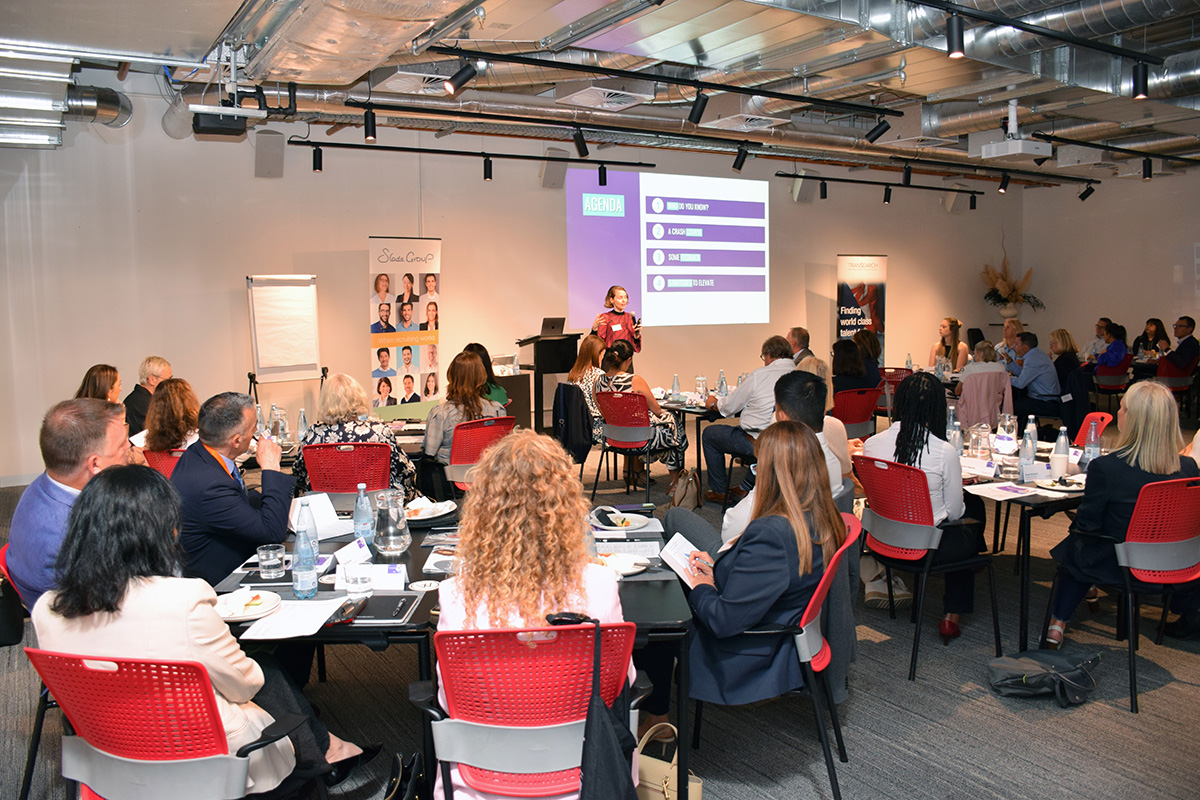(or How you can be a more Influential Leader)
Last week Slade Group had the privilege of hosting Michelle Rushton, Director of People of Influence, one of Australia’s most accomplished international speakers on leadership. For anyone who has seen Michelle in action, you know you’re in for captivating presentation, and this session on Executive Influence did not disappoint!
Michelle’s presentation centred on a compelling question: What makes the best leaders stand out and command an audience the moment they enter a room?
Before we dived into the magic behind those impactful leaders, the room took a moment to reflect: Can you think of leaders in your life who exude that irresistible presence? What is it about them that draws you in, that makes you want to listen, learn, and follow?
Referencing a thought-provoking study published in Harvard Business Review, Professors Susan Fiske, Amy Cuddy, and Peter Glick unpack the essence of magnetic leadership. They argue that two key traits are present in every great leader, and these traits stem from questions we ask ourselves when encountering them for the first time.
Picture this: You’re at an informal gathering, meeting the new leader of an organisation. What do you subconsciously ask yourself?
“What are this person’s intentions towards me?” and “Can they actually follow through on those intentions?”
This internal dialogue reveals the heart of what great leaders embody: Warmth and Strength. People of Influence call this the Smiling Ox® Paradox. These are the two magical traits that distinguish outstanding leaders from the crowd, and they are crucial to forming genuine connections.

But what exactly do these traits look like? Let’s break them down:
Warmth: Trustworthy, Likable, and Giving
When it comes to warmth, it’s all about how a leader makes you feel. Are they trustworthy? Do they make you feel valued and understood? Are they willing to give, both emotionally and professionally? Great leaders who exude warmth create an environment where people feel safe and supported.
Strength: Competent, Committed & Confident
On the flip side, strength reflects a leader’s ability to inspire confidence. Can they get the job done? Are they composed under pressure? Do they stick to their word? Strength encompasses not only competence and commitment, but also the ability to stay grounded and confident in difficult situations, inspiring others to follow with trust and respect.
Interestingly, the study suggests that while many leaders excel in one of these traits over the other, the key to outstanding leadership is to be high in both of them. If you find yourself stronger in one area, it’s about closing the gap by strengthening the other. For example, if you find that your competence is lacking in a particular area, seek out new experiences – both theoretical and practical – to ‘hone’ that skill. But remember, this doesn’t mean abandoning what you’re already good at! It’s about finding harmony between warmth and strength.
An intriguing point Michelle made during the session was the resilience of the strength trait. While a single negative incident can sometimes impact a leader’s warmth, it typically doesn’t diminish their strength in the same way. Strength, it seems, is more ‘forgiving’ than warmth.
A Bold Challenge: Presenting in a “Testosterone-Filled” Room
A question from the audience that stood out: How should you approach a room filled with tough, dominant personalities for the first time?
Michelle’s answer was both strategic and practical. To gain credibility in such an environment, a strong, confident approach is essential from the start. Once you’ve earned that initial respect, you can dial down and present your natural style.
Discovering Your Leadership Traits
To make things even more interactive, Michelle guided us through a couple of hands-on exercises. The first involved a fascinating activity where we had to approach 20 people and quickly assess whether they exuded more warmth or strength. Of course, smiles often skewed our judgments, leading to some interesting mix-ups – where strength was mistakenly categorised as warmth. It was a fun and enlightening exercise in first impressions.
Next, we took a survey that provided insight into our individual leadership profiles, breaking down the traits into their sub-elements – trustworthiness, likeability, competence, confidence and composure, etc. This gave us a roadmap for identifying areas of growth and development in our own leadership journeys.
Reflecting on the Leaders Who Inspire You
Now, back to the initial question: Have you ever found yourself captivated by a leader, drawn to their presence? Upon reflection, did they possess warmth and strength? More importantly, did they master the sub-elements that made them the influential figure you admired?
The truth is the leaders we’re naturally drawn to often embody a balance of both warmth and strength. It’s this combination that leaves a lasting impact, creating not just followers, but loyal advocates.
So, the next time you meet someone with leadership potential, ask yourself: Do they possess these magical traits? And perhaps, more importantly, how can you strengthen your own leadership presence by cultivating these qualities within yourself?

If you have any questions about leadership development or would like to be included in future events, please reach out to Barry Hodson or Vincent Borg.

Vincent Borg has extensive experience in the health sector, having worked both in private and not-for-profit organisations. His previous roles as General Manager at Healthscope, St. Vincent’s Private Hospital and Epworth Healthcare saw him oversee large, multi-site facilities in the acute and sub-acute services, including greenfield operations. Vincent’s recent operational experience means he is well-connected with industry thought leaders, across all segments of the sector. As such, he has a clear understanding of issues many hospital executives are currently experiencing and the emerging issues impacting health care providers. Read more…

